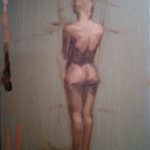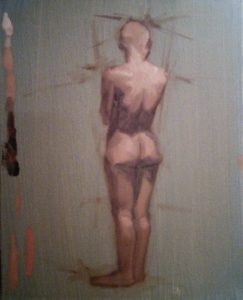Learning to paint the planes of the figure

What spirit is so empty and blind, that it cannot recognize the fact that the foot is more noble than the shoe,and skin more beautiful than the garment with which it is clothed?
Michelangelo
 During the first week of school, we focussed on planes of the figure. What does that mean? Ah – it means we are squinting and painting the largest shapes first. We are also relying on the study of anatomy to inform what we see.
During the first week of school, we focussed on planes of the figure. What does that mean? Ah – it means we are squinting and painting the largest shapes first. We are also relying on the study of anatomy to inform what we see.
On Tuesdays and Thursdays we are painting the figure with a process called “Duotone.” What does Duotone mean? My best understanding is that it’s a combination of using a limited palette and the neutral grey of the canvas to paint the figure.
There is also a strict requirement to build the paint thinly. This means we paint the block-in or grisaille stage with burnt sienna and ultramarine blue paint and just a smidge of odorless mineral spirits. Then we mix cadmium orange with titanium white to thinly paint in the ‘middle range’ value of the figure. We do this while keeping in mind the anatomy. In other words, we don’t just fill in the blanks of the under painting.
Once we have finished the middle range value, we paint the highest value and the darkest value. As we work, we are consciously leaving room for the neutral grey background of the canvas to act as a value in the painting. Typically, this grey value is a ‘dark light.’ I did not clearly use the grey value of the canvas for this painting. So, this is something I will think about this coming week. I cannot tell you how much brain power this process takes. It is an incredibly challenging but satisfying process to squint and let yourself see the most prominent values first.
The painting in this blog post is my best effort for this week. Why? Because I only show simple planes on the top of the shoulders through to the middle of the back. Then at the back of the buttocks, I used a lower value. But the value of the shadows in the legs was not quite as dark as the shadow in the back. Why? Because there was reflected light from the model stand onto the models legs. But mostly, I love the feeling this painting expresses of a woman standing and contemplating.
That’s the latest from art school world. I hope it offers you a bit of relief from the frenzy that is happening on a daily basis these days!

5 Comments
Annie Nashold
September 19, 2016Hey Julie
I love your intentional description of every step! I sense your brain power working hard. It is all inspiring!!
Julie Holmes
September 19, 2016Hi Annie, Yes – the amount of brain power required at this place is – well – incredible…and sometimes a wee bit overwhelming.
But that’s part of the appeal, too.
Hope all is well in your art world and thank you for reading!!
Heather
September 30, 2016I love the way you describe your steps and what you’re learning. You’re amazing! Miss you!
Julie Holmes
October 10, 2016Thank you so much Heather!
I am hoping to be able to refer back to this for reference, too.
Miss you, toooooooo.
Julie Holmes, Fine Artist Model's posing - Julie Holmes, Fine Artist
October 13, 2016[…] to study both the figure and portraits. I outlined the steps for this process in an earlier post here. Some other art schools follow a similar approach and may call this a process using a limited […]